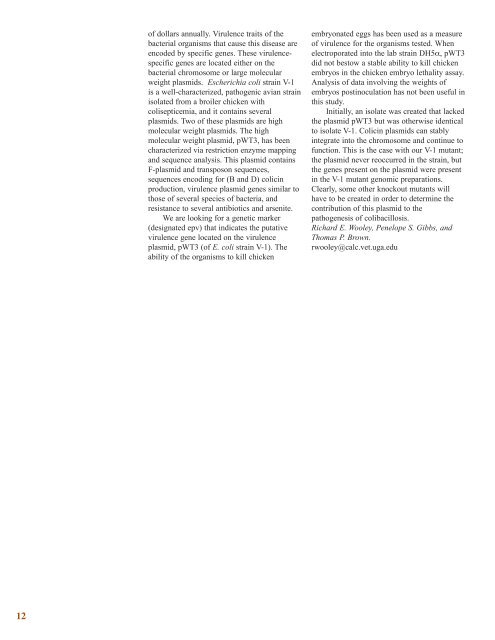<strong>of</strong> the numbers <strong>of</strong> tests performed during thisreporting period. PCR techniques for infectiousbronchitis virus have been significantlyimproved to provide same-day results withvirtually no down time. A new mycoplasmaPCR technique has been adopted and refined,which has improved turnaround time from 1.5days to 3 hours. Other techniques forperforming large volume processing <strong>of</strong> PCRsamples are being pursued and will provideeven better turnaround for large submissions.Research will continue and new PCR tests willbe applied to diagnostics as applications aredeveloped and other ways are investigated toimprove service to poultry industry clients.Diagnostic Services Laboratory activity isrepresented by 5,361 accessions, 25,216bacterial procedures, 315 antimicrobialsusceptibilities, 33,823 enzyme-linkedimmunoadsorbent assay (ELISA), 24,782infectious bronchitis virus-hemagglutinationinhibition (IBV-HI) tests, 748 agar gelprecipitin tests, 30,100 histopathology slides,2,063 diagnostic PCR tests, and 998necropsies.Stephan G.Thayer, Thomas P. Brown, StanleyH. Kleven, Mark W. Jackwood, MaricarmenGarcia, John R. Glisson, George N. Rowland,Pedro Villegas, Jean E. Sander, John J.Maurer, and Stanley A. Vezeysthayer@arches.uga.eduMethods for isolation, identification, andcontrol <strong>of</strong> avian virusesPathogenic viruses, which present acontinual hazard to the commercial poultryindustry, are the basis <strong>of</strong> our current research.More than 600 virus isolation cases weresubmitted last year to the virology laboratoryat the Poultry Diagnostic and Research Center.Specifically, diseases caused by infectiousbronchitis virus (IBV), avian leukosis virussubgroup J (ALV-J), and infectious bursaldisease virus (IBDV) are the focus <strong>of</strong> thislaboratory’s ongoing research.Variant IBV strains are common to theU.S. and world poultry industries. Numerousunique IBV isolates from diseased commercialflocks in <strong>Georgia</strong> have been identified. Theprotection provided by currently availablecommercial vaccines is not as satisfactory asexpected. Therefore, challenge studies areconducted and evaluated in order to developproducts that provide better protection againstthese IBV variants.A new and ubiquitous exogenous strain <strong>of</strong>avian leukosis virus belonging to the subgroupJ has recently been reported. An increase incondemnations at processing plants, mortalitywith or without tumors, a decrease in eggproduction, and depletion <strong>of</strong> chick uniformityare some <strong>of</strong> the effects <strong>of</strong> this virus. Because<strong>of</strong> the recent identification <strong>of</strong> ALV-J, minimalgenomic information is available. Currently,virus isolation in specific cell culture alongwith the use <strong>of</strong> molecular techniques such asRT-PCR and sequence analysis are being usedto generate data for progressive research onALV-J pathogenicity and oncogenicity.IBDV is an acute and highly transmissiblevirus, which can cause clinical disease andmortality along with immunosuppresion inyoung chickens. Variant IBDV isolates fromproblematic commercial broiler flocks areselected for evaluation in challenge studies andclinical analysis. Molecular analysis is used torapidly identify and classify IBDV strains.This has led to the recent discovery andidentification <strong>of</strong> a very virulent strain <strong>of</strong> IBDVfor the first time in the American continent.Monitoring <strong>of</strong> IBDV field isolates allows formodification <strong>of</strong> vaccination procedures inorder to provide improved protection againstpathogenic viruses.Pedro Villegas, John El-Attrache, HollySellers, Miguel Ruano, Alejandro Banda, andCarlos Estevezpedrov@arches.uga.eduThe role <strong>of</strong> a large molecular weightplasmid in the pathogenesis <strong>of</strong> avianEscherichia coliFinancial losses caused by colibacillosiscosts the poultry industry hundreds <strong>of</strong> millionsDr. Miguel Ruano from Ecuador inspects inoculated embryos at the Virology Section<strong>of</strong> the Poultry Diagnosic and Research Center.11
<strong>of</strong> dollars annually. Virulence traits <strong>of</strong> thebacterial organisms that cause this disease areencoded by specific genes. These virulencespecificgenes are located either on thebacterial chromosome or large molecularweight plasmids. Escherichia coli strain V-1is a well-characterized, pathogenic avian strainisolated from a broiler chicken withcolisepticemia, and it contains severalplasmids. Two <strong>of</strong> these plasmids are highmolecular weight plasmids. The highmolecular weight plasmid, pWT3, has beencharacterized via restriction enzyme mappingand sequence analysis. This plasmid containsF-plasmid and transposon sequences,sequences encoding for (B and D) colicinproduction, virulence plasmid genes similar tothose <strong>of</strong> several species <strong>of</strong> bacteria, andresistance to several antibiotics and arsenite.We are looking for a genetic marker(designated epv) that indicates the putativevirulence gene located on the virulenceplasmid, pWT3 (<strong>of</strong> E. coli strain V-1). Theability <strong>of</strong> the organisms to kill chickenembryonated eggs has been used as a measure<strong>of</strong> virulence for the organisms tested. Whenelectroporated into the lab strain DH5α, pWT3did not bestow a stable ability to kill chickenembryos in the chicken embryo lethality assay.Analysis <strong>of</strong> data involving the weights <strong>of</strong>embryos postinoculation has not been useful inthis study.Initially, an isolate was created that lackedthe plasmid pWT3 but was otherwise identicalto isolate V-1. Colicin plasmids can stablyintegrate into the chromosome and continue t<strong>of</strong>unction. This is the case with our V-1 mutant;the plasmid never reoccurred in the strain, butthe genes present on the plasmid were presentin the V-1 mutant genomic preparations.Clearly, some other knockout mutants willhave to be created in order to determine thecontribution <strong>of</strong> this plasmid to thepathogenesis <strong>of</strong> colibacillosis.Richard E. Wooley, Penelope S. Gibbs, andThomas P. Brown.rwooley@calc.vet.uga.edu12
- Page 1 and 2: VScienceM E S ‘9 9In Service To A
- Page 3: VMES ObjectivesThe Veterinary Medic
- Page 6 and 7: Emerging DiseasesEmerging diseases
- Page 8 and 9: lymphocytes. Heterophils incorporat
- Page 10 and 11: Live MG vaccines are an effective c
- Page 14 and 15: FishGeorgia’s aquaculture industr
- Page 16 and 17: Cattle and Other RuminantsCattle, s
- Page 19 and 20: HorsesThe Georgia horse industry is
- Page 21 and 22: SwineThe productivity of swine herd
- Page 23 and 24: monocytes/macrophages, and persists
- Page 25 and 26: Financial HighlightsResearch Fundin
- Page 27 and 28: Lukert, P.D. Bovine enteric disease
- Page 29 and 30: ResearchersAllen, Douglas, Jr., DVM
- Page 31 and 32: Selected Publications*Albers, T.M.,
- Page 33: Hafner, S., Latimer, K.: Cilia-asso
- Page 36: Young, E.A., Cornish, T.E., Little,

















